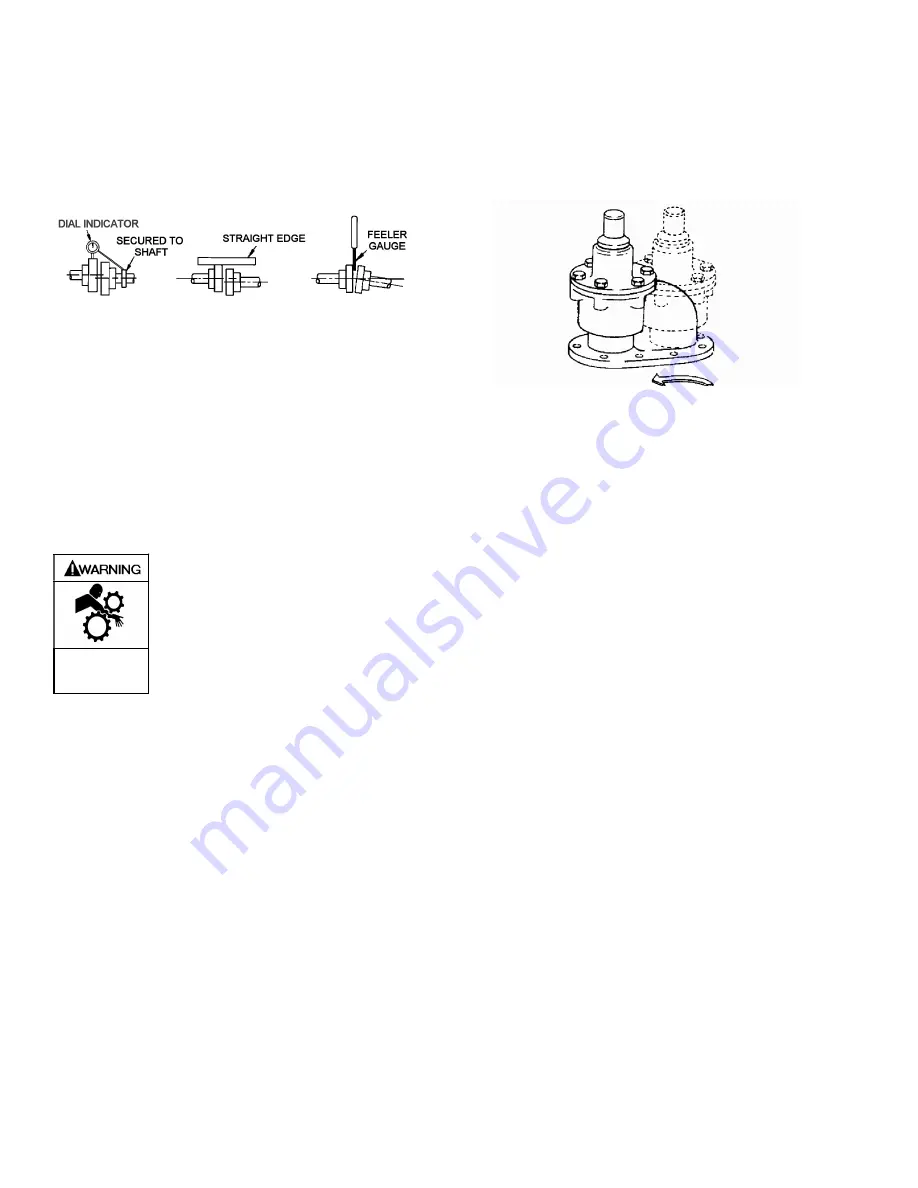
102-A00 page 4/16
INSTALLATION
COUPLING ALIGNMENT
The pump must be directly coupled to a gear and/or driver
with a flexible coupling. Verify coupling alignment after
installation of new or rebuilt pumps. Both angular and parallel
coupling alignment MUST be maintained between the pump,
gear, motor, etc. in accordance with manufacturer’s
instructions. See Figure 3.
Figure 3 – Alignment Check
1. Parallel alignment: The use of a laser alignment tool or
dial indicator is preferred. If a laser alignment tool or dial
indicator is not available, use a straightedge. Turn both
shafts by hand, checking the reading through one
complete revolution. Maximum offset should be less
than .005" (0.127 mm).
2. Angular alignment: Insert a feeler gauge between the
coupling halves. Check the spacing at 90° increments
around the coupling (four check points). Maximum
variation should not exceed .005" (125 microns). Some
laser alignment tools will check angular alignment as
well.
Operation without guards in place can
cause serious personal injury, major
property damage, or death.
Do not operate
without guard
in place
PUMP ROTATION
To determine pump rotation:
If the intake port is on the right, with the drive end of the shaft
pointing towards the observer, the pump is
right-hand
, or
CLOCKWISE rotation.
If the intake is on the left, with the drive end of the shaft
pointing towards the observer, the pump is
left-hand
, or
COUNTERCLOCKWISE rotation.
NOTICE:
Confirm correct pump rotation by checking the pump
rotation arrows respective to pump driver rotation.
TO CHANGE PUMP ROTATION
The vanes (14) must be reversed so that the relief grooves
face in the direction of rotation. On HXL10, HXL8 and HXLJ8
models, reverse the liner (41). If equipped with a pump
mounted relief valve, it must also be reversed (see Figure 4).
Refer to “Pump Disassembly” and “Pump Assembly” sections
of this manual for parts removal and replacement instructions.
Figure 4 – Reversing the Relief Valve
CHECK VALVES
If a check valve is used, install it at the pump discharge. The
use of check valves or foot valves in the supply tank is not
recommended with self-priming, positive displacement
pumps.
If the possibility of liquid backflow exists when the pump is off,
a check valve in the pump discharge piping is recommended
because the pump can motor in the reverse rotation and
create undue stress on all attached components. Never start
a pump when it is rotating in the reverse rotation as the
added starting torque can damage the pump and related
equipment.
MANUAL BYPASS VALVES
A bypass line from the pump discharge to the pump suction
with a manual shut-off valve is recommended when handling
volatile or viscous liquids at a high lift, or when delivering to
piping too small to take the full flow from the pump.
The following size of manual bypass valve and recirculating
lines are normally recommended:
6" pump
8" pump
10" pump
2" valve and piping
3" valve and piping
4" valve and piping
When handling very viscous liquids, excessive pressures may
develop when starting the system. To avoid possible damage
to the pump, open the manual bypass valve before starting.
After the pressure stabilizes and the pump is running
smoothly, close the valve slowly to increase the flow through
the system until maximum acceptable system performance is
attained.
As heavy liquids with “light ends” are heated to a higher
temperature to lower the viscosity, the amount of volatile
product given off is increased. The resulting cavitation may
cause the pump to become noisy and begin vibrating. By
cracking the manual bypass valve open and permitting some
of the liquid to recirculate back to the pump inlet pipe or to the
supply tank, the noise and vibration can be reduced to an
acceptable level. If the pump noise and vibration cannot be
controlled with the manual bypass valve, look for other
causes of noise in the “Troubleshooting” section of this
manual.


































